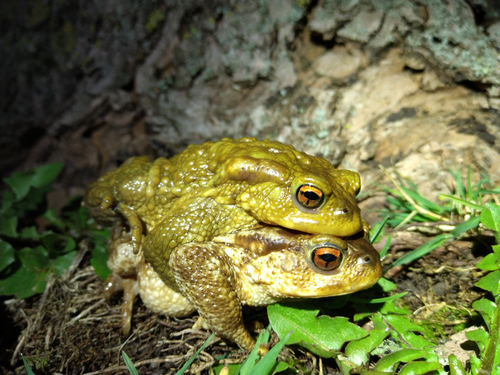
MARTIN-LAURENT Fabrice
Recommendations: 0
Review: 1
Review: 1

Maternal body condition affects the response of larval spined toads' faecal microbiome to a widespread contaminant
Effects of AMPA on Bufo spinosus microbiota
Recommended by Marie-Agnès Coutellec based on reviews by Fabrice Martin-Laurent, Lauris Evariste and 1 anonymous reviewerThe overall pollution of air, water, and soil is currently recognized as one of the five main drivers of biodiversity loss (IPBES 2019). Among chemicals, pesticides play a significant role in this global crisis, as recently re-assessed at the scale of France (Pesce et al. 2023). In this context, although parent molecules are subject to national and international regulations, based on a priori ecological risk assessment (e.g., REACH) as well as monitoring in some environments (see e.g., pesticides classified in the priority list of substances by the Water Frame Directive), pesticide metabolites are rarely considered. In the case of the widely used herbicide glyphosate, a particular concern is rising about its primary metabolite, aminomethylphosphonic acid (AMPA), due to its persistence and overlooked toxicity.
Amphibians are the most threatened class of vertebrates on earth, with two in every five species considered threatened with extinction (IUCN Red List). While this overall decline has multiple causes, the contribution of pesticides is suspected to be significant in some regions.
In this context, Tartu et al. (2024) studied the effects of AMPA on the gut microbiota of the spined toad, Bufo spinosus. This work complements a previous study which showed embryo mortality, oxidative stress, deformities at hatching, and delayed development (Tartu et al. 2022). Using a common garden experiment based on populations from contrasted habitats (agricultural vs woodland, same as in the previous study), the authors captured breeding pairs and collected the eggs laid in the laboratory. These were exposed to 0.4 µg/L AMPA during embryonic and larval development. Individual microbiota was analysed non-invasively, i.e., using the faeces collected in treatment vessels. Bacterial biodiversity was genetically assessed (16S rRNA). The community biomass and taxonomic structure were analysed as a function of chemical treatment, mother and father body condition (fat vs thin), as well as population of origin.
As a primary effect, AMPA reduced the microbial biomass. Furthermore, a significant interaction was detected between AMPA and mother condition on the community structure and composition. This alteration, observed in « fat » females only, was reflected through a significant decrease in Bacteroidota and a significant increase in Actinobacteriota (the latter being consistent with the ability of some species in this phylum to use AMPA as a source of phosphorus). The higher sensitivity of tadpoles from females in better condition seems counterintuitive, since better body condition is expected to be associated with higher fitness (and possibly higher ability to face chemical stress), the authors discuss this in the light of the literature (which shows that microbiome-fitness relationships are not often evidenced in natural populations), and hypothesize that these females in better conditions host a microbiota that may be more efficient, yet also more sensitive to AMPA. Not ruling out other possible factors ignored in their study, in particular genotypic effects, the authors further discuss the importance of maternally transmitted effects via the microbiota.
Altogether, the results published by Tartu et al. (2024) provide important new findings on AMPA toxicity to amphibian microbiota, and also confirm the occurrence of vertical transmission of the microbiota from mother to progeny in this vertebrate class.
References
IPBES (2019). Global assessment report on biodiversity and ecosystem services of the Intergovernmental Science-Policy Platform on Biodiversity and Ecosystem Services. E. S. Brondizio, J. Settele, S. Díaz, and H. T. Ngo (editors). IPBES secretariat, Bonn, Germany. 1148 pages. https://doi.org/10.5281/zenodo.3831673
Pesce, S., Mamy, L., Sanchez, W., et al. (2023). Main conclusions and perspectives from the collective scientific assessment of the effects of plant protection products on biodiversity and ecosystem services along the land–sea continuum in France and French overseas territories. Environ Sci Pollut Res . https://doi.org/10.1007/s11356-023-26952-z
Tartu, S., Renoirt, M., Cheron, M., Gisselmann, L.-L., Catoire, S., Brischoux, F. (2022). Did decades of glyphosate use have selected for resistant amphibians in agricultural habitats? Environ. Pollut. 310, 119823. https://doi.org/10.1016/j.envpol.2022.119823
Tartu, S., Pollet, N., Clavereau, I., Gauthier Bouchard, G., Brischoux, F. (2024). Maternal body condition affects the response of larval spined toads’ faecal microbiome to a widespread contaminant. bioRxiv, ver. 2 peer-reviewed and recommended by Peer Community in Ecotoxicology and Environmental Chemistry. https://doi.org/10.1101/2023.12.18.572122